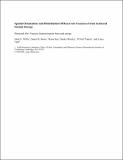Spatial Orientation and Distribution of Reservoir Fractures from Scattered Seismic Energy
Author(s)
Willis, Mark E.; Burns, Daniel R.; Rao, Rama V. N.; Minsley, Burke J.; Toksoz, M. Nafi; Vetri, Laura; ... Show more Show less
DownloadWillis_fractures06.pdf (1.925Mb)
Other Contributors
Massachusetts Institute of Technology. Earth Resources Laboratory
Metadata
Show full item recordAbstract
We present the details of a new method for determining the reflection and scattering characteristics of seismic
energy from subsurface fractured formations. The method is based upon observations we have made from 3D finite
difference modeling of the reflected and scattered seismic energy over discrete systems of vertical fractures.
Regularly spaced, discrete vertical fracture corridors impart a coda signature, which is a ringing tail of scattered
energy, to any seismic waves which are transmitted through or reflected off of them. This signature varies in
amplitude and coherence as a function of several parameters including: 1) the difference in angle between the
orientation of the fractures and the acquisition direction, 2) the fracture spacing, 3) the wavelength of the
illuminating seismic energy, and 4) the compliance, or stiffness, of the fractures. This coda energy is the most
coherent when the acquisition direction is parallel to the strike of the fractures. It has the largest amplitude when the
seismic wavelengths are tuned to the fracture spacing, and when the fractures have low stiffness. Our method uses
surface seismic reflection traces to derive a transfer function which quantifies the change in an apparent source
wavelet before and after propagating through a fractured interval. The transfer function for an interval with no or
low amounts of scattering will be more spike-like and temporally compact. The transfer function for an interval
with high scattering will ring and be less temporally compact. When a 3D survey is acquired with a full range of
azimuths, the variation in the derived transfer functions allows us to identify subsurface areas with high fracturing
and determine the strike of those fractures. We calibrated the method with model data and then applied it to the
Emilio field with a fractured reservoir giving results which agree with known field measurements and previously
published fracture orientations derived from PS anisotropy.
Description
Shortened title: Fracture characterization from coda energy
Date issued
2006Publisher
Massachusetts Institute of Technology. Earth Resources Laboratory
Series/Report no.
Earth Resources Laboratory Industry Consortia Annual Report;2006-14